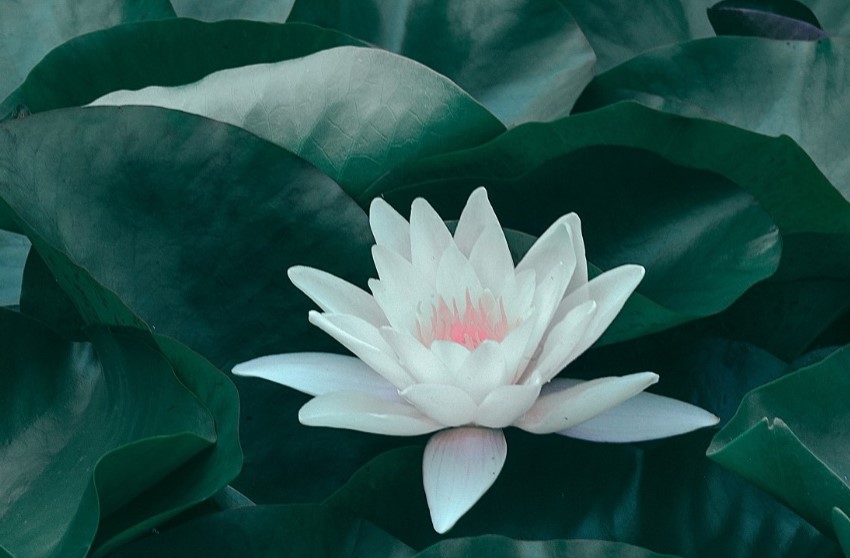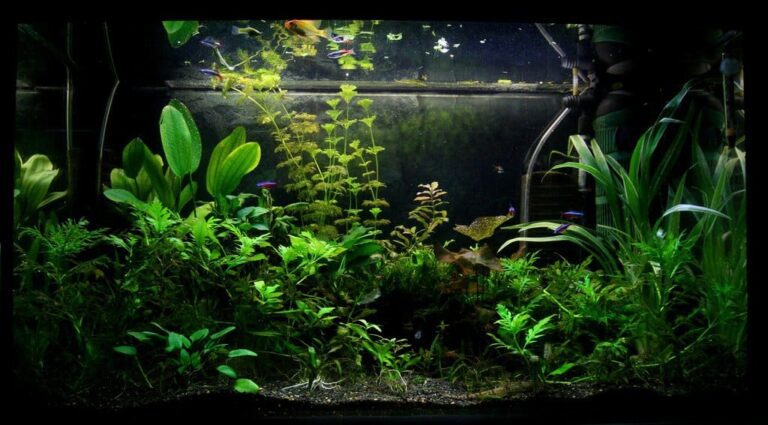Peace Lilies (Spathiphyllum wallisii) are a wonderful addition to any indoor living space. These beauties are native to South America and parts of Central America.
There’s something so exquisite about their luscious light green leaves and dainty white flowers that brightens up even the dullest spaces. You probably didn’t know that Peace Lilies grow in aquariums too.
Yes, you read right.

These stunning plants can coexist in perfect harmony with your betta fish, adding to the aesthetic appeal of your aquarium.
This guide takes an in-depth look at how to grow Peace Lily in your fish tank and everything you need to know about how to properly care for them.
What You Need to Grow Peace Lily in Aquarium: Requirements
Right off the bat, you need to create a conducive environment for your Peace Lilies, which means understanding the conditions in which they thrive. Peace Lilies do well in low-light, high-humidity environments.
Getting the humidity part down shouldn’t be a problem since they’ll grow out of the water, providing the necessary moisture required for them to thrive.
The lighting can get tricky if your indoor spaces are flooded with natural light streaming through large windows.
Place your aquarium in a room with no more than two natural light sources. If you rely on artificial light to illuminate your space, keep the tank in a corner away from too much bright light.
On the other hand, you don’t want them in a dark area. If the space your aquarium is in is too dark, consider installing at least one LED or fluorescent light to mimic direct sunlight.
Next, you need to consider the substrate you’ll use. The aquarium in which you intend to plant Peace Lily should have a layer of substrate that would be classified as “well-draining.”
Think – sand or gravel topped with a generous amount of aquatic soil. The idea behind this is to provide the aquarium plant with all the nutrients it requires to thrive without necessarily “drowning” the roots.
Remember, your Peace Lily’s roots will be submerged in water. This increases the likelihood of root rot. Incorporating a substrate that doesn’t log water allows the lily’s roots to drain excess fluid, preventing decay.
The water’s temperature and pH are factors you also need to keep in mind when growing Peace Lilies in an aquarium. For best results, you want to maintain the water at a temperature that’s anywhere between 68°F and 82°F.
The pH level, which denotes how acidic or alkaline the water is, should be from 6.0 to 7.0. Levels higher or lower than this could end up killing your plants.
The same applies to other aquatic plant species such as Pothos, Lucky Bamboo, Java Fern, Water Lily, Water Lettuce, and Spider Plant.
How to Prepare Your Fish Tank to Plant Peace Lily
So far, we’ve established what you need to provide the right growth conditions for growing Peace Lily in aquarium. Next, you need to prepare the fish tank for planting.
At the risk of stating the obvious, you first need to clean your tank, especially if it has betta fish, live rock, coral, algae, debris, or anything else that could harm your lilies.
Start off by emptying the fish tank of everything it has. We’re talking fish, coral, substrate, decorations – you name it. This will allow you to clean it thoroughly and remove any toxic elements that could harm your plants.
Next, use a wet microfiber towel to clean the interior of the fish tank to remove any mineral buildup or algae that may be stuck on the walls.
Whatever you do, don’t use household detergents or other chemical-based cleaning agents to clean the glass. Use a natural aquarium cleaner if you must. In most cases, good old-fashioned water does the trick.
Once you’ve given it a good scrub, you’ll need to sanitize it. Again, do not use household products or disinfectants to do this. Instead, mix a solution of distilled white vinegar and warm water in a ratio of 1-to-5. Spray the entire interior surface of the aquarium and let it sit for about 15 minutes.
Then, rinse it thoroughly with clean water before wiping it dry using a clean microfiber towel.
Rinse the items you had taken out of the tank thoroughly (except the betta fish, of course) with fresh water before replacing them in the tank. Line the gravel or sand substrate first and then top it with aquarium soil which you’ll need to grow Peace Lily.
Then, carefully fill the tank with fresh water and let it stand for at least two hours to let the debris settle.
This would be the time to add the required treatments to optimize the tank’s pH level. There are several methods you can use to achieve this, including:
- Reverse osmosis (RO): This technique uses a special filtration system designed to get rid of minerals and other impurities in the water responsible for raising or lowering pH levels.
- Addition of acid/alkali elements: White vinegar and baking soda are widely used to alter pH levels.
- Use of chemical buffers: Marine buffers work by maintaining the existing pH of the aquarium. They can neutralize small amounts of acidic or alkaline elements in the water to keep its pH stable.
You’ll need to monitor the betta fish tank’s pH levels to ensure they remain optimal for your lilies and marine life.
How to Care and Maintain Peace Lily in Aquarium
One of the greatest perks of growing Peace Lilies is how low-maintenance they are. They thrive in low-light conditions and propagate with little to no effort or intervention.
They are also highly resistant to pests and disease and require no day-to-day input on your part to keep them alive. If that’s not low maintenance, we don’t know what is.
That said, there are a few things you can do to ensure your Peace Lilies thrive in your aquarium. For starters, remember to change the water frequently and ensure the filtration system is working properly.
You should also make a point to add aquarium-friendly aquatic plant fertilizers to give your lilies the nutrients they need to grow and flourish. Other fertilizers can be toxic to marine life.
Finally, keep an eye on the water temperature and pH to make sure the water conditions sustain the growth of your plants.
Potential Issues That May Arise When Growing Peace Lilies in an Aquarium
As great as Peace Lilies are, you might run into problems when growing plants like these. If you do, the good news is most of them are pretty easy to fix.
One potential problem you might encounter is mold and algae overgrowth. In most cases, there’s no way to side-step this. It comes with the territory since there’s a lot of water and moisture involved.
You just have to figure out how to deal with it. A simple solution to this issue involves cleaning the tank every once in a while with a vinegar-water solution.
Changing the water regularly and installing a filtration system slows down the growth of mold and algae, which should buy you time between aquarium deep cleaning sessions.
If your plant’s leaves start to turn yellow, it might indicate a lack of adequate light exposure. The easy fix for this issue is to install an LED or fluorescent light near the aquarium or move the tank closer to a source of direct sunlight.
If leaves are still yellow even after a week of increasing light exposure, it might be due to a mineral deficiency. If that’s the case, consider removing the affected leaves and adding fertilizer to the soil substrate.
Another common problem you might encounter is rotting roots. An easy fix for this issue is using a well-draining substrate such as sand or gravel before adding a layer of aquarium soil. You can then plant java moss if you like.
Bottom Line
Growing Peace Lily in aquarium is a lot easier than you think. With the right amount of care, you will enjoy the aesthetic appeal it adds to your aquarium and, in turn, interior space.
The tips detailed in this guide are a great starting point for anyone looking to zhuzh up their fish tank with some live plants.
In the meantime, are you looking for ways to get rid of phosphate from your aquarium? You might want to check out these phosphate removers.






